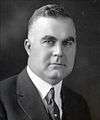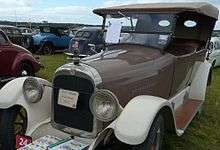Frederick Morrell Zeder
Frederick Morrell Zeder (March 19, 1886 – February 24, 1951) was an American automotive industry engineer and a member of the Automotive Hall of Fame.[1][2]
Frederick Morrell Zeder | |
|---|---|
 Zeder in 1922 | |
| Born | March 19, 1886 Bay City, Michigan, USA |
| Died | February 24, 1951 (aged 64) |
| Alma mater | University of Michigan |
| Occupation | |
| Political party | Democrat |
Early life
Zeder was born on March 19, 1886.[3] Then his family lived in Bay City, Michigan. Zeder's parents were Rudolph Zeder (from New York) and Matilta Jane Zeder (from Canada). Zeder had 4 brothers and 1 sister. He had little formal schooling at the Bay City public schools and was put to work earning income for the family at the age of 11. His first job was as a helper being a machinist's apprentice for Industrial Works of Bay City (manufacturer of railroad cranes).[4][5][6]
At age 12 Zeder was a railroad call boy (waking up the train crew in the morning). Also at age 12 he had a job in the railroad industry, inspecting the railroad car axles to make sure they were oiled and greased properly.[7]
Mid life
Zeder became a machinist at Michigan Central Railroad in their Motive Power and Train Divisions in his teens.[6] He was still in high school when he started working for the railroad company. After graduating from public high school in 1905 Zeder went to the University of Michigan and worked part-time as a dishwasher and prepared vegetables for a restaurant. He graduated from Michigan in 1909 with the degree of Bachelor of Science in mechanical engineering.[3][4][5][6] He was still living at home with his 4 brothers and a sister in 1910 and his trade is recorded in the 1910 U.S. Census as a mechanical engineer.[8]
Career
Allis-Chalmers
In 1909 after graduating from Michigan, Zeder was hired by the Allis-Chalmers Company in West Allis, Wisconsin, near Milwaukee for their apprentice course as an erecting engineer.[6][7] This is where he met Carl Breer. Allis-Chalmers selected twenty-five of the best students of mechanical engineering from top universities of the United States. Besides Zeder, Carl Breer was such a student. Breer was from Stanford University. Zeder and Breer became close friends in their training at Allis-Chalmers.[5][9][10]
Studebaker to Willys

Zeder then was hired in 1910 by a power plant in Detroit helping to build it. His next job, later in 1910, was at the E-M-F Company in Detroit taking charge of their engineering laboratory working on car body design, while still a consultant of the Detroit power plant construction project. Studebaker brothers (wagon builders) took over E-M-F. in 1912 to produce Studebaker automobiles. Zeder was first a consulting engineer for them. Later in 1914, at the age of 28, he was promoted as Studebaker's chief engineer.[4][5][6][7]
The Three Musketeers
Studebaker reached their production peak in 1916, however had major financial problems and was about to be bankrupt. Zeder saw this as a weakness in the engineering department and hired two key knowledgeable mechanical engineers, Carl Breer and Owen Skelton, to form a new engineering nucleus. These three engineers were referred to as "The Three Musketeers" by those who knew them.[2][6][11] Zeder was the vice president of Studebaker and his main job was that of being in charge of engineering. Breer, because of his analytical skills, was made the director of research laboratories. Skelton was put in charge of design.[5]
Zeder originally got acquainted with Breer at Allis-Chalmers where they apprenticed at the same time in 1910 in mechanical engineering. In 1914 Zeder enticed Breer to come over to Studebaker to work with him in their engineering department. Zeder's relationship with Breer was quite close. Breer even married one of Zeder's sisters. Of the three engineers Zeder was considered the "front man" because of his charismatic personality and advanced engineering talents.[6] Skelton had engineering talents for engines and transmitting its power to the wheels and Breer had technical engineering design abilities.[12]
Chrysler
"The Three Musketeers" of Studebaker and Willys—Zeder, Skelton, and Breer—were brought by Walter Chrysler over to the nascent Chrysler Corporation and became the heart of its engineering department, which over the next 50 years would earn a reputation in the automotive industry as one of the best such departments at any major manufacturing corporation. The Chrysler cars of the 1920s and 1930s featured many firsts in automobile engineering. For example, Lee Iacocca credited Frederick Zeder, who became Chrysler's chief of engineering, with leading the development of rubber motor mounts.[13] Iacocca said that Zeder "was the first man to figure out how to get the vibrations out of cars. His solution? He mounted their engines on a rubber base."[13]
Later life and honors
In 1933 the Chrysler Graduate School of Engineering Research combined with the Chrysler Institute of Engineering to form one charter. It offered engineering degrees including a doctorate in engineering. Credits were honored by four accredited colleges by 1937 including the University of Michigan. Zeder was the Institute's first president. He received an honorary doctorate of engineering with the first graduation exercises in 1933. Inducted to Automotive Hall of Fame (1998).[14]
References
- Breer, p. xi.
- "Fred Zeder/Hall of Fame Inductees". Automotive Hall of Fame. 2000. Retrieved 23 December 2012.
- Curcio, p. 270.
- Breer, p. 5.
- Fred Zeder, Vice President in Charge of Engineering
- The Encyclopedia of America Business History and Biography (The Automobile Industry 1920-1980), Zeder-Skelton-Breer Engineering by Richard P. Scharchburg; p. 501
- Three Musketeers - ZSB
- 1910 U.S. Federal Census; Census Place: Bay Ward 7, Bay, Michigan; Roll: T624_637; Page: 5A; Enumeration District: 0047; ; FHL microfilm: 1374650.
- Curcio, p. 272.
- Breer, p. 1.
- Men of Chrysler
- Curcio, pp. 271, 272.
- Iacocca 1984, p. 149.
- "Chrysler Institute of Engineering". allpar.com. Retrieved 24 December 2012.
Bibliography
- Breer, Carl; Yanik, Anthony J, Editor; SAE Historical Committee (December 1994), The Birth of Chrysler Corporation and Its Engineering Legacy (illustrated ed.), Warrendale, PA: Society of Automotive Engineers, ISBN 1560915242
- Curcio, Vincent (2001), Chrysler: The Life and Times of an Automotive Genius (illustrated ed.), Oxford University Press, ISBN 0195147057
- Iacocca, Lido A.; William Novak (1984), Iacocca: An Autobiography, Bantam Books, ISBN 978-0553051025, LCCN 84045174.
- Weiss, H. Eugene (2003), Chrysler, Ford, Durant, and Sloan: Founding Giants of the American Automotive Industry (illustrated ed.), McFarland, ISBN 0786416114